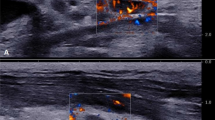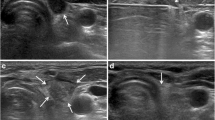Abstract
Purpose
Surgical removal is recommended for recurrent thyroid carcinomas (RTCs) unable to uptake radioiodine and/or not responsive to chemotherapy. However, repeated neck dissection is difficult for surgeons. Thus, radiofrequency ablation (RFA) was proposed for RTCs. The aim of this prospective study is to assess RTC treatment response after RFA, according to well-established criteria.
Methods
Sixteen lesions in 13 patients were treated by RFA. All patients refused/were excluded from repeated surgery or other conventional therapy. CT and US examinations were performed before RFA to evaluate lesion volume and vascularization. All RFA procedures were performed under US-guidance by an 18-gauge, electrode. Treatment response was evaluated by CT, according to RECIST 1.1 and to mRECIST guidelines; CT examinations were performed during follow-up (6–18 months); the volume of residual vital tumour tissue and the percentage of necrotic tissue were estimated by contrast enhanced CT.
Results
RFA was well tolerated by all patients; in two cases laryngeal nerve paralysis was observed. Mean pre-treatment volume was 4.18 ± 3.53 ml. Vital tumour tissue and percentage of necrosis at 6, 12 and 18 months were 0.18 ± 0.25, 0.11 ± 0.13, 0.29 ± 0.40 ml and 91.9 ± 11.1, 90.4 ± 13.3, 80.8 ± 23.1%. According to RECIST 1.1, target lesion response was classified as complete response (CR) in one case, partial response (PR) in 11/16, stable disease in 4/16 cases. According to mRECIST, 11/16 cases were classified as CR and the remaining 5 as PR.
Conclusion
RFA is a safe procedure to treat the viable tumour tissue and to reduce the RTC volume; as to the criteria to assess treatment response, mRECIST appears to be more accurate.







Similar content being viewed by others
References
Aschebrook-Kilfoy B, Ward MH, Sabra MM, Devesa SS (2011) Thyroid cancer incidence pattern in United States by histologic type, 1992–2006. Thyroid 21:125–134
Enewold L1, Zhu K, Ron E, Marrogi AJ, Stojadinovic A, Peoples GE, Devesa SS (2009) Rising thyroid cancer incidence in the United States by demographic and tumor characteristics, 1980–2005. Cancer Epidemiol Biomarkers Prev 18:784–791
Nixon IJ, Simo R, Newbold K, Rinaldo A, Suarez C, Kowalski LP, Silver C, Shah JP, Ferlito A (2016) Management of invasive differentiated thyroid cancer. Thyroid 26(9):1156–1166
Clayman GL, Steward DL (2016) Management of persistent or recurrent structural neck disease in differentiated thyroid carcinoma: point and counterpoint. JAMA Otolaryngol Head Neck Surg 142(8):789–791
Jin LX, Moley JF (2016) Surgery for lymph node metastases of medullary thyroid carcinoma: a review. Cancer 122(3):358–366
Wells SA Jr, Asa SL, Dralle H, Elisei R, Evans DB, Gagel RF, Lee N, Machens A, Moley JF, Pacini F, Raue F, Frank-Raue K, Robinson B, Rosenthal MS, Santoro M, Schlumberger M, Shah M, Waguespack SG, American Thyroid Association Guidelines Task Force on Medullary Thyroid Carcinoma (2015) Revised American Thyroid Association guidelines for the management of medullary thyroid carcinoma. Thyroid 25:567–610
Esnaola NF, Cantor SB, Sherman SI, Lee JE, Evans DB (2001) Optimal treatment strategy in patients with papillary thyroid cancer: a decision analysis. Surgery 130:921–930
Cayonu M, Acar A, Eryilmaz A, Oguz O (2014) Surgical approach and outcomes for revision surgery of the central neck compartment. J Craniofac Surg. 25(5):1797–1800
Shaha AR (2008) Revision thyroid surgery—technical considerations. Otolaryngol Clin North Am 41(6):1169–1183
Mauri G, Cova L, Monaco CG, Sconfienza LM, Corbetta S, Benedini S, Ambrogi F, Milani V, Baroli A, Ierace T, Solbiati L (2016) Benign thyroid nodules treatment using percutaneous laser ablation (PLA) and radiofrequency ablation (RFA). Int J Hyperth 15:1–5 (Epub ahead of print)
Perez CL, Fighera TM, Miasaki F, Mesa Junior CO, Paz Filho GJ, Graf H, Carvalho GA (2014) Evaluation of percutaneous ethanol injections in benign thyroid nodules. Arq Bras Endocrinol Metabol 58(9):912–917
Deandrea M, Limone P, Basso E et al (2008) US-guided percutaneous radiofrequency thermal ablation for the treatment of solid benign hyperfunctioning or compressive thyroid nodules. Ultrasound Med Biol 34(5):784–791
Cervelli R, Mazzeo S, De Napoli L, Boccuzzi A, Pontillo-Contillo B, Materazzi G, Miccoli P, Cioni R, Caramella D (2017) Radiofrequency ablation in the treatment of benign thyroid nodules: an efficient and safe alternative to surgery. J Vasc Interv Radiol S1051–0443(17):30664–30664 (Epub ahead of print)
Haugen BR, Alexander EK, Bible KC, Doherty GM, Mandel SJ, Nikiforov YE, Pacini F, Randolph GW, Sawka AM, Schlumberger M, Schuff KG, Sherman SI, Sosa JA, Steward DL, Tuttle RM, Wartofsky L (2016) 2015 American thyroid association management guidelines for adult patients with thyroid nodules and differentiated thyroid cancer: the American thyroid association guidelines task force on thyroid nodules and differentiated thyroid cancer. Thyroid 26(1):1–133
Park KW, Shin JH, Han BK, Ko EY, Chung JH (2011) Inoperable symptomatic recurrent thyroid cancers: preliminary result of radiofrequency ablation. Ann Surg Oncol 18:2564–2568
Lim HK, Baek JH, Lee JH, Kim WB, Kim TY, Shong YK, Hong SJ (2015) Efficacy and safety of radiofrequency ablation for treating locoregional recurrence from papillary thyroid cancer. Eur Radiol 25:163–170
Kim SY, Kim SM, Chang H, Kim BW, Lim CY, Lee YS, Chang HS (2017) Long-term outcomes of ethanol injection therapy for locally recurrent papillary thyroid cancer. 274:3497–3501
Suh CH, Baek JH, Choi YJ, Lee JH (2016) Efficacy and safety of radiofrequency and ethanol ablation for treating locally recurrent thyroid cancer: a systematic review and meta-analysis. Thyroid 26:420–428
Zhao Q, Tian G, Kong D, Jiang T (2016) Meta-analysis of radiofrequency ablation for treating the local recurrence of thyroid cancers. J Endocrinol Invest 39(8):909–916
Bernardi S, Stacul F, Zecchin M, Dobrinja C, Zanconati F, Fabris B (2016) Radiofrequency ablation for benign thyroid nodules. J Endocrinol Invest 39:1003–1013
Dupuy DE, Monchik JM, Decrea C, Pisharodi L (2001) Radiofrequency ablation of regional recurrence from well-differentiated thyroid malignancy. Surgery 130(6):971–977
Lee SJ, Jung SL, Kim BS, Ahn KJ, Choi HS, Lim DJ, Kim MH, Bae JS, Kim MS, Jung CK, Chong SM (2014) Radiofrequency ablation to treat locoregional recurrence of well-differentiated thyroidcarcinoma. Korean J Radiol 15(6):817–826
Na DG, Lee JH, Jung SL, Kim JH, Sung JY, Shin JH, Kim EK, Lee JH, Kim DW, Park JS, Kim KS, Baek SM, Lee YH, Chong S, Sim JS, Huh JY, Bae JI, Kim KT, Han SY, Bae MY, Kim YS, Baek JH (2012) Radiofrequency ablation of benign thyroid nodules and recurrent thyroid cancers: consensus statement and recommendations. Korean J Radiol 13:117–125
Garberoglio R, Aliberti C, Appetecchia M, Attard M, Boccuzzi G, Boraso F, Borretta G, Caruso G, Deandrea M, Freddi M, Gallone G, Gandini G, Gasparri G, Gazzera C, Ghigo E, Grosso M, Limone P, Maccario M, Mansi L, Mormile A, Nasi PG, Orlandi F, Pacchioni D, Pacella CM, Palestini N, Papini E, Pelizzo MR, Piotto A, Rago T, Riganti F, Rosato L, Rossetto R, Scarmozzino A, Spiezia S, Testori O, Valcavi R, Veltri A, Vitti P, Zingrillo M (2015) Radiofrequency ablation for thyroid nodules: which indications? The first Italian opinion statement. J Ultrasound 18:423–430
Negro R, Attanasio R, Grimaldi F, Frasoldati A, Guglielmi R, Papini E, on behalf of AME (Associazione Medici Endocrinologi) and AACE (American Association of Clinical Endocrinologists)] (2017) A 2016 Italian survey about guidelines and clinical management of thyroid nodules. Eur Thyroid J 6:75–81
Eisenhauera EA, Therasseb P, Bogaertsc J, Schwartzd LH, Sargente D, Fordf R, Danceyg J, Arbuckh S, Gwytheri S, Mooneyg M, Rubinsteing L, Shankarg L, Doddg L, Kaplanj R, Lacombec D, Verweijk J (2009) Eur J Cancer 45:228–247
Lencioni R, Llovet JM (2010) Modified RECIST (mRECIST) assessment for hepatocellular carcinoma. Semin Liver Dis 30(1):52–60
van Klaveren RJ, Aerts JG, de Bruin H, Giaccone G, Manegold C, van Meerbeeck JP (2004) Inadequacy of the RECIST criteria for response evaluation in patients with malignant pleural mesothelioma. Lung Cancer. 43:63–69
Choi H, Charnsangavej C, de Castro FS et al (2004) CT evaluation of the response of gastrointestinal stromal tumors after imatinib mesylate treatment: a quantitative analysis correlated with FDG PET findings. AJR Am J Roentgenol 183:1619–1628
Yang D, Woodard G, Zhou C, Wang X, Liu Z, Ye Z, Li K (2016) Significance of different response evaluation criteria in predicting progression-free survival of lung cancer with certain imaging characteristics. Thorac Cancer. 7(5):535–542
Fournier L, Ammari S, Thiam R, Cuénod CA (2014) Imaging criteria for assessing tumour response: RECIST, mRECIST. Cheson Diagn Interv Imaging. 95(7–8):689–703
Giovagnorio F, Martinoli C (2001) Sonography of the cervical vagus nerve: normal appearance and abnormal findings. AJR 176(3):745–749
Tubbs RS, Loukas M, Shoja MM, Blevins D, Humphrey R, Chua GD, Kelly DR, Oakes WJ (2007) An unreported variation of the cervical vagus nerve: anatomical and histological observations. Folia Morphol (Warsz) 66(2):155–157
Baek JH, Kim YS, Lee D, Huh JY, Lee JH (2010) Benign predominantly solid thyroid nodules: prospective study of efficacy of sonographically guided radiofrequency ablation versus control condition. AJR Am J Roentgenol 194:1137–1142
Baek JH, Kim YS, Sung JY, Choi H, Lee JH (2011) Locoregional control of metastatic well-differentiated thyroid cancer by ultrasound-guided radiofrequency ablation. AJR Am J Roentgenol 197:W331–W336
Kim MN, Kim BK, Han KH, Kim SU (2015) Evolution from WHO to EASL and mRECIST for hepatocellular carcinoma: considerations for tumor response assessment. Expert Rev Gastroenterol Hepatol 9(3):335–348
Kim C, Lee JH, Choi YJ, Kim WB, Sung TY, Baek JH (2017) Complications encountered in ultrasonography-guided radiofrequency ablation of benignthyroid nodules and recurrent thyroid cancers. Eur Radiol 27(8):3128–3137
Oddo S, Spina B, Vellone VG, Giusti M (2017) A case of thyroid cancer on the track of the radiofrequency electrode 30 months after percutaneous ablation. J Endocrinol Invest 40:101–102
Funding
No competing financial interests exist.
Author information
Authors and Affiliations
Corresponding author
Ethics declarations
Conflict of interest
On behalf of all authors, the corresponding author states that there is no conflict of interest.
Ethical approval
The study was approved by our Ethical Committee.
Informed consent
All patients signed an informed consent to be enroled in the study and to perform the RFA procedure.
Rights and permissions
About this article
Cite this article
Mazzeo, S., Cervelli, R., Elisei, R. et al. mRECIST criteria to assess recurrent thyroid carcinoma treatment response after radiofrequency ablation: a prospective study. J Endocrinol Invest 41, 1389–1399 (2018). https://doi.org/10.1007/s40618-018-0886-0
Received:
Accepted:
Published:
Issue Date:
DOI: https://doi.org/10.1007/s40618-018-0886-0




